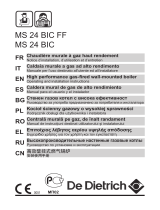
240011373, REV F (07/30/16)
2
INSTALLER Section
CONTENT
SAFETY INFORMATION ..............................................................................................................................................................................3
DEFINITIONS ...............................................................................................................................................................................................3
SPECIAL ATTENTION BOXES .....................................................................................................................................................................3
OTHER DEFINITIONS ..................................................................................................................................................................................3
BEFORE INSTALLING AND WHEN SERVICING THE BOILER ..................................................................................................................4
DURING BOILER OPERATION ....................................................................................................................................................................4
BOILER WATER ...........................................................................................................................................................................................4
FREEZE PROTECTION FLUIDS .................................................................................................................................................................. 4
HEATING APPLIANCE REMOVAL FROM A COMMON VENT SYSTEM .....................................................................................................5
CONDENSATE REMOVAL SYSTEM............................................................................................................................................................5
1. INTRODUCTION ...........................................................................................................................................................................................6
2. TECHNICAL DATA ........................................................................................................................................................................................6
2.1 PERFORMANCE ..........................................................................................................................................................................................6
2.2 PARAMETERS SETTING FOR HIGH ALTITUDE ......................................................................................................................................... 7
2.3 SYSTEM .......................................................................................................................................................................................................7
2.4 MAIN COMPONENTS ..................................................................................................................................................................................7
2.5 GENERAL INSTALLATION INFORMATION .................................................................................................................................................8
2.6 ELECTRICAL ................................................................................................................................................................................................8
2.7 AVAILABLE PUMP HEAD FOR CENTRAL HEATING ..................................................................................................................................8
2.8 SYSTEM VOLUME .......................................................................................................................................................................................9
2.9 BOILER SCHEMATIC ...................................................................................................................................................................................9
2.10
BOILER INFORMATION MENU ...................................................................................................................................................................10
3. GENERAL BOILER INFORMATION .............................................................................................................................................................13
SERVICE CLEARANCES .............................................................................................................................................................................13
3.1 SELECTING THE BOILER LOCATION ........................................................................................................................................................14
3.2 POSITIONING THE BOILER ........................................................................................................................................................................14
3.3 FIT THE BOILER ...........................................................................................................................................................................................14
3.4 FLUSHING THE SYSTEM ............................................................................................................................................................................14
3.5 GAS SUPPLY ................................................................................................................................................................................................ 14
3.6 ELECTRICAL SUPPLY .................................................................................................................................................................................15
3.7 AIR SUPPLY .................................................................................................................................................................................................15
3.8 DOMESTIC HOT WATER MODE .................................................................................................................................................................15
FOR DUNKIRK BOILER DCC-150 and DCB-125 WITH INDIRECT TANK .................................................................................................15
3.9
FROST PROTECTION MODE ..................................................................................................................................................................... 15
3.10 PUMP PROTECTION ...................................................................................................................................................................................15
3.11 GAS PIPING .................................................................................................................................................................................................15
4. VENT SYSTEM .............................................................................................................................................................................................16
INSTALLING EXHAUST VENT AND INTAKE AIR VENT ..............................................................................................................................16
4.1
APPROVED VENTING MATERIALS
.............................................................................................................................................................17
CONCENTRIC VENT SUPPORT .................................................................................................................................................................18
FLUE OPTIONS ............................................................................................................................................................................................18
CONCENTRIC VENT SCREW PLACEMENT ..............................................................................................................................................19
SEPARATED HORIZONTAL FLUE TERMINALS INSTALLATION OPTIONS ..............................................................................................20
SEPARATED FLUE TERMINALS .................................................................................................................................................................20
TWO PIPE VENT SUPPORT ........................................................................................................................................................................21
5.
BOILER LOCATION ......................................................................................................................................................................................24
6.
CENTRAL HEATING SYSTEM .....................................................................................................................................................................24
7.
FILLING THE CENTRAL HEATING SYSTEM ..............................................................................................................................................25
8.
TOXIC CHEMICALS .....................................................................................................................................................................................26
9.
HEATING SYSTEM AND REFRIGERATION ................................................................................................................................................26
10.
INSTALLATION ..............................................................................................................................................................................................26
10.1
CONNECT THE PIPEWORK ........................................................................................................................................................................26
11.
ELECTRICAL CONNECTIONS .....................................................................................................................................................................26
11.1 CONNECTING THE 120 V ROOM THERMOSTAT ..................................................................................................................................... 27
11.2 CONNECTING THE 24 V ROOM THERMOSTAT ........................................................................................................................................27
11.3 ACCESSORIES ............................................................................................................................................................................................28
12.
SPECIAL FUNCTIONS .................................................................................................................................................................................30
12.1 COMMISSIONING ........................................................................................................................................................................................30
12.2 DE-AERATION FUNCTION ..........................................................................................................................................................................30
12.3 CHIMNEY SWEEP FUNCTION ....................................................................................................................................................................31
12.4 COMBUSTION ADJUSTMENT FUNCTION (CO
2
%) ....................................................................................................................................31
12.5 ERROR MESSAGES AND RESETTING THE BOILER ................................................................................................................................32
13.
OPERATING THE BOILER ...........................................................................................................................................................................33
13.1 TESTING FOR GAS LEAKS AND PURGINING THE GAS SUPPLY ...........................................................................................................33
13.2 BOILER CONTROLS ....................................................................................................................................................................................33
13.3 GAS VALVE ...................................................................................................................................................................................................34
CHANGING THE TYPE OF GAS ..................................................................................................................................................................35
14.
PARAMETER SETTINGS .............................................................................................................................................................................36
14.1 ADJUSTING MAXIMUM HEATING POWER ................................................................................................................................................36
15.
ANNUAL SERVICING ...................................................................................................................................................................................36
15.1 HYDRAULIC UNIT ........................................................................................................................................................................................37
15.2 FINAL COMMISSIONING .............................................................................................................................................................................37
15.3 FINAL ASSEMBLY ........................................................................................................................................................................................38
15.4 USER INFORMATION ..................................................................................................................................................................................38
16.
BOILER OPERATION ...................................................................................................................................................................................38
16.1 CENTRAL HEATING MODE .........................................................................................................................................................................38
16.2 DOMESTIC HOT WATER MODE .................................................................................................................................................................38
16.3 FROST PROTECTION..................................................................................................................................................................................38
16.4 PUMP ............................................................................................................................................................................................................38
16.5 LWCO - LOW WATER CUT OFF ..................................................................................................................................................................38
16.6 SAFETY FLUE THERMOSTAT .....................................................................................................................................................................39
16.7 FLUE PRESSURE SWITCH .........................................................................................................................................................................39
16.8 REPLACEMENT OF PARTS .........................................................................................................................................................................39
AUTOMATIC CALIBRATION FUNCTION .....................................................................................................................................................39
17.
ROUTINE SERVICING .................................................................................................................................................................................40
IMPORTANT NOTES PRIOR TO SERVICING .............................................................................................................................................40
18.
COMPONENT REPLACEMENT AND PERIODIC CLEANING .....................................................................................................................41
18.1 DRAINING THE BOILER ..............................................................................................................................................................................41
18.2 ELECTRODES ..............................................................................................................................................................................................41
19.
WIRING DIAGRAMS .......................................................................................................................................................................................43
A.
APPENDIX A - APPROVED TERMINATIONS OPTIONS.............................................................................................................................89




















